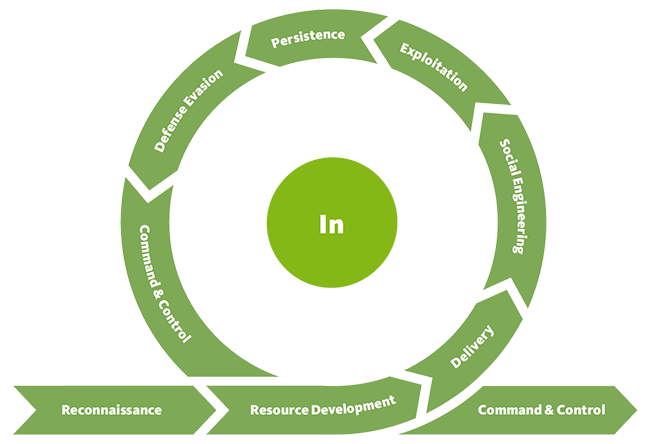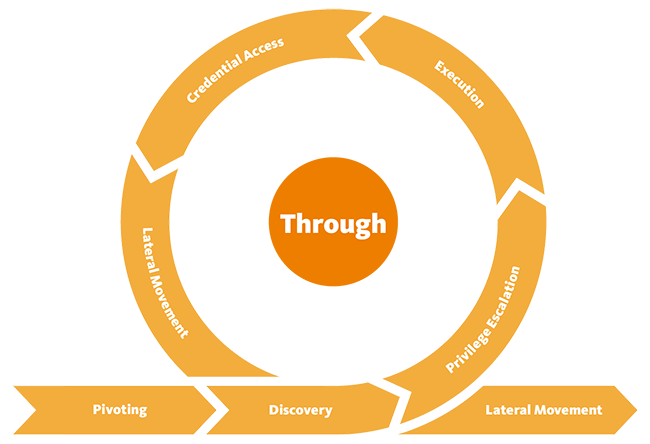Unified Kill Chain
Author: Roger C.B. Johnsen
Introduction
The Unified Kill Chain (UKC) is a comprehensive framework designed to describe and analyze cyber attacks by mapping the entire lifecycle of an adversary’s operation. It merges key concepts from two popular models: the Cyber Kill Chain (CKC) and MITRE ATT&CK. By combining the strengths of both, UKC provides a holistic view of attack techniques, from reconnaissance and initial intrusion to lateral movement and impact. This helps cybersecurity professionals enhance threat detection, improve defenses, and streamline incident response by understanding attackers’ methods at each stage of an attack.
About Model
The Unified Kill Chain (UKC) categorizes the attack lifecycle into three main phases: In, Through, and Out. The In phase focuses on the initial access and foothold within the target environment, the Through phase covers lateral movement and persistence, and the Out phase involves data exfiltration or the attacker achieving their objectives. This structure provides a clear understanding of an adversary’s progression, helping defenders to detect, respond to, and mitigate threats more effectively at each stage.
Phases
Notice that each phase is built of multiple steps. For instance, the steps in the “IN” phase is
- Reconnaissance
- Resource development
- Delivery
- Social Engineering
- Exploitation
- Persistence
- Defense evasion
- Command and control
Bear in mind, in an attack, an adversary doesn’t have to fulfill or pace through each step. Some steps can and will be skipped depending on the TTP’s of the adversary. Speaking of TTP’s, if you look closely, each step in each phase can (with some exceptions outlined in the design PDF) be mapped with the Mitre Att&ck Framework. This means, as I use the model, whenever I do threat hunting I use this model as a notebook (along with the Diamond Model). By carefully mapping out whatever the adversay are trying to do up against the Mitre Att&ck framework, I can place which phase attack is in. Paired with the Diamond Model I have a great system for basing my reports and further investigation on.
Anyway, let’s have a closer look at each phases:
In-phase
The phase is about:
- Preparation
- Initial Compromise
- Establish Foothold
Through-phase
The “through” phase is about:
- Escalate Privileges
- Internal Reconnaissance
- Move Laterally
Out-phase
The “out” phase is about:
- Maintain Presence
- Complete Mission
- Exfiltration & Impact
Example
Consider a cyberattack on a financial institution using the UKC framework:
In:
- Preparation: Attackers gather information on employees.
- Initial Compromise: Phishing email delivers malware.
- Establish Foothold: Malware installs a backdoor.
Through:
- Escalate Privileges: Attackers exploit vulnerabilities for admin rights.
- Internal Reconnaissance: Network scans identify critical systems.
- Move Laterally: Attackers use stolen credentials to access other systems.
Out:
- Maintain Presence: Persistent backdoors ensure ongoing access.
- Complete Mission: Attackers exfiltrate sensitive financial data.
- Exfiltration & Impact: Data is transferred out, and ransomware is deployed.
Practical Application
In
- Detection: Monitor for reconnaissance and phishing attempts.
- Response: Conduct security awareness training and implement email filtering.
Through
- Detection: Identify privilege escalation and lateral movement.
- Response: Enforce least privilege and use network segmentation.
Out
- Detection: Monitor for data exfiltration and ransomware activity.
- Response: Deploy data loss prevention tools and maintain regular backups.
Why It Is Better Than Lockheed Martin’s Cyber Kill Chain
The Unified Kill Chain is considered more effective than Lockheed Martin’s Cyber Kill Chain for several reasons:
- Comprehensiveness: The UKC encompasses a broader range of attack techniques and stages, covering the entire attack lifecycle in more detail.
- Integration: It integrates insights from multiple models, including MITRE ATT&CK, providing a more holistic view.
- Flexibility: The division into “In, Through, Out” allows for more targeted and specific defensive measures at each phase.
- Depth: It addresses more advanced and sophisticated attack techniques, enabling organizations to defend against a wider array of threats.
By leveraging the Unified Kill Chain, organizations can systematically enhance their threat detection and response capabilities, improving overall security posture and reducing the likelihood of successful attacks.
Resources
Books:
- “The Unified Kill Chain: A Comprehensive Guide to Cyber Defense” by Paul Pols
Websites:
Tools:
- Threat intelligence platforms
- Endpoint detection and response (EDR) solutions
- Network monitoring tools
- Security information and event management (SIEM) systems
Revision
| Revised Date | Comment |
|---|---|
| 06.10.2024 | Improved formatting and wording |

